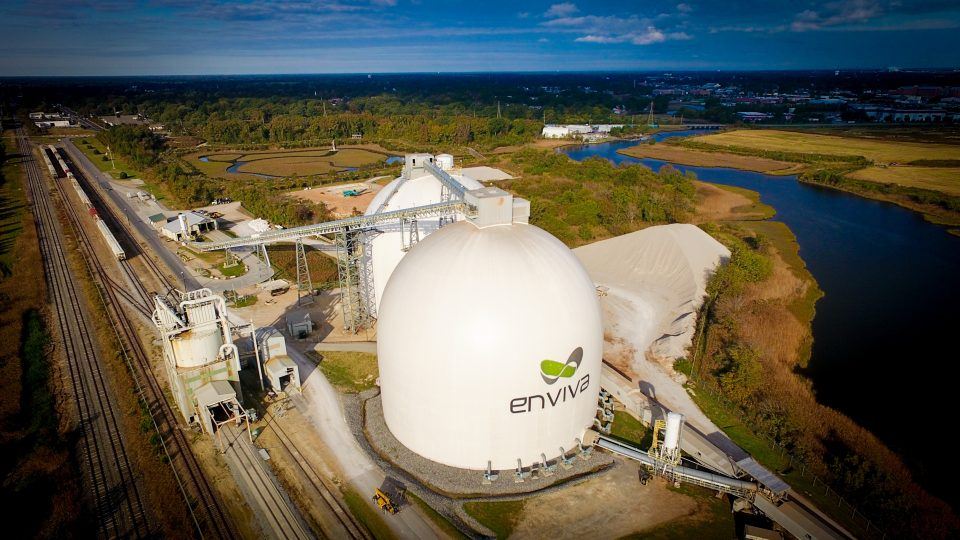Dome Technology is building a fifth dome for biomass manufacturer Enviva, this time at the Port of Pascagoula on the Gulf of Mexico in Mississippi, USA.
The dome will store 45,000 metric tons of sustainably sourced wood pellets and stands 157 feet tall and 175 feet in diameter. Pellets will be delivered to the site by rail, then stored within the dome. Gravity will draw 70 to 75 percent of the stored pellets to the reclaim tunnel, and front-end loader will be utilized to collect the rest as needed. Upon reclaim, pellets will be loaded into ships to be sent to Enviva customers in Asia and Europe.
Repeat collaboration with Enviva took shape in the spring of 2011 and November 2012, when Dome Technology built two domes for the company at the Port of Chesapeake in Virginia, USA (see photo below). These domes, which stand 157 feet high and 176 feet in diameter and store 45,000 metric tons of pellets apiece, include systems for continuous monitoring and temperature control. Dome Technology’s team completed construction ahead of projected completion, even though the project started a month later than planned.

Five years later Enviva again contracted Dome Technology to build two additional, almost identical domes at the Port of Wilmington, North Carolina, USA (pictured below). This pair of domes stand 170 feet tall, boast a capacity of 45,000 metric tons each, and can withstand hurricane-force winds. The Pascagoula dome has been engineered with the same wind resistance.

“We chose to collaborate with Dome Technology not only because of their reliable and well-proven technology, but also because they know our industry and team well,” said Norb Hintz, Enviva’s senior vice president and chief engineer. “The Pascagoula dome is their fifth installation with us. They have become familiar with our operating procedures and share the same discipline and commitment to safe work practices.”
Dome Technology strives to embrace innovative ideas with every project. One example shows up in the design of the Pascagoula aeration troughs. Originally these were designed to be wide and shallow to allow for the necessary volume of air. But with a wide opening, the thickness of the grate on top had to be substantial to remain rigid when front-end loader traveled across, and the grate cost was surprisingly high. Dome Technology suggested shrinking the troughs’ width and adding to their depth. This will allow the troughs to have efficient airflow and for the grates to be narrower—and more economical.
Adopting creative solutions has helped secure multiple Enviva projects. “Enviva trusts us. They know that we’re competent, that we will perform, that we bring value to their projects and look at lowering costs,” said Dome Technology sales manager Lane Roberts.
Dome Technology’s scope of work at Pascagoula includes overseeing the deep-foundation system built by Berkel & Company, dome and floor construction, tunnel construction, aeration troughs, heat sensors, elevated entryway and the drain around dome.
Construction of the Pascagoula dome is set for completion in May 2021. Inflation is critical to a dome’s construction; this airform establishes the shape of the structure, and once inflated, polyurethane foam insulation is applied to the interior of the airform.
Steel reinforcement is attached to the insulation, and concrete is then applied using the shotcrete method. When completed, the dome is a robust reinforced concrete structure that can withstand even the most aggressive weather at portside locations.
Sealed and seamless, the dome provides ideal storage conditions for products, like wood pellets, that require a controlled environment. The airform surrounding the dome prevents water and moisture entrance. No other silo option offers this level of waterproof protection, and the dome’s exterior requires almost zero superficial maintenance. Also, the dome’s insulated nature reduces heating and cooling of the walls and air inside, preventing condensation from forming on the interior.
Dome Technology is driven by the pursuit of innovation and advancement. The current Enviva project highlights Dome Technology’s breadth of expertise.
“For nearly four decades we’ve relied on a collaborative approach with companies—they’re in the driver seat, and we help navigate,” said Dome Technology CEO Bradley Bateman. “In every project Dome Technology incorporates innovative technology to maximize storage capacity and system performance with an economical solution.”
Editor’s note: This article was published in the October 2020 issue of Dry Cargo International.